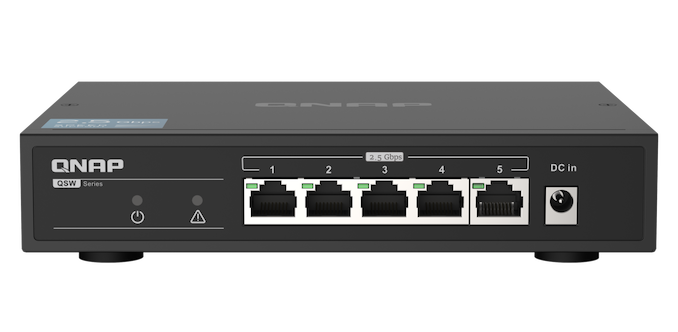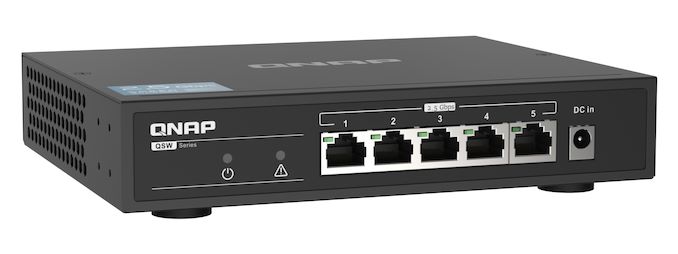At Last, a 2.5Gbps Consumer Network Switch: QNAP Releases QSW-1105-5T 5-Port Switch
by Ryan Smith on July 17, 2020 11:30 AM EST- Posted in
- Networking
- QNAP
- NBASE-T
- 2.5GBase-T
- Ethernet
- 2.5 GbE

After entirely too long of a delay, the wait for faster consumer-grade network switches appears to be coming to an end. This week QNAP launched its QSW-1105-5T switch, one of the industry’s first unmanaged 2.5Gbps (2.5GBASE-T) switches. The 5-port switch supports 2.5GbE operation on all five of its RJ45 Ethernet ports, and along with being unmanaged it is also fanless, allowing the switch to work maintenance-free and installed virtually anywhere. The QSW-1105-5T is already on sale in Taiwan for roughly $100, meaning that we’re looking at a price-per-port of about $20.
The saga of NBASE-T has been something of a long one. First introduced in 2016, the standard added the then-new 2.5GBASE-T and 5GBASE-T modes, which were designed to offer a series of intermediate steps between the existing 1Gbps (1000BASE-T) and 10Gbps (10GBASE-T) standards. By scaling down parts of the 10GBASE-T spec, the new standards would allow more modest – but still many times faster – network transmission rates than 1Gbps Ethernet, all the while being able to reuse existing Cat5e and Cat6 cabling. Overall, 2.5GBASE-T allows for 2.5Gbps Ethernet over Cat5e at the same 100m distances as 1Gbps Ethernet, while 5GBASE-T allows for 5Gbps speeds over 100m runs of Cat6, as well as quasi-official support for shorter Cat5e runs.
Given the technology reuse, moderately-priced NBASE-T network cards were quick to hit the market. However affordable switches have been a more complex matter: while the high initial price of NBASE-T was easy enough to eat on a single controller, multiplied over several ports on a switch, it quickly drove up the price tag. As a result, the market for NBASE-T switches has largely between split between downgraded pro gear like Netgear’s $70-per-port XS505M, and mixed-port switches like Asus’s XG-U2008, which offer just two 10G/NBASE-T ports along with a slew of Gigabit Ethernet ports. So cheap NBASE-T networking options have remained elusive, at least until now.
Thankfully, in the last year we’ve finally started seeing the slower of the NBASE-T modes, 2.5GBASE-T, sprint towards wide adoption. The 2.5Gbps standard is the cheapest to implement, and with recent controller releases from the likes of RealTek and Intel, 2.5Gbps controllers have quickly become a staple on high-end motherboards. Accordingly, with the price per port coming down for 2.5Gbps controllers, it’s also bringing down the price of whole switches. And this is where QNAP’s new switch comes in.
The QSW-1105-5T is one of the first switches to be released using these new generations of cheap controllers. Aimed squarely at the home and SMB markets, the switch doesn’t offer any frills such as network management, Power over Ethernet, or SFP+ ports. Instead it focuses on the things that matter for the home market: supporting 2.5Gbps networking in a small, passively-cooled switch that’s suitable to be neglected by being tucked under a desk or in a closet.
| QNAP QSW-1105-5T Switch | |
| Speeds | 100M/1G/2.5G |
| Ports (RJ45) | 5 |
| Managed | No |
| Power | 12 W |
| Dimensions | 3.4 x 18 x 14.5 cm |
| Cooling | Passive (Fanless) |
| Price | ~$100 |
As the first of what will undoubtedly be many 2.5G switches over the coming months, the QSW-1105-5T also gives us our first real look at what we can expect from this generation of switches as far as footprints and power consumption goes. Since it’s not carved from a pro-grade switch, the 18 cm x 14.5 cm switch is significantly smaller than earlier NBASE-T switches. And with a maximum power consumption rating of 12 W, we’re looking at power consumption of just a bit over 2 Watts per port, which is also a significant improvement over admittedly far more powerful switches.
All of which sounds unremarkable, and indeed that’s exactly what makes the QSW-1105-5T so interesting. The biggest barrier to wide consumer adoption over the last few years has been the cost – both in regards to the core technology and added frills – so we’ve been waiting for quite a while to see NBASE-T technology transition from pro-grade switches to cheap, consumer-grade gear.
Otherwise, QNAP’s new switch is further evidence that the PC industry is going to coalesce around 2.5Gbps Ethernet for the time being. Besides being the fastest standard to officially and fully support Cat5e cabling – which was installed in walls en masse when home networking first took off – it’s also the cheapest and lowest-power option. This is allowing it to be widely deployed not only in new motherboards and cheap USB adapters, but finally in switches as well – and making QNAP’s new switch a good match for all of those new NICs. And while I’d like to see cheaper 5Gbps and 10Gbps gear as well, 5GBASE-T seems likely to remain a premium (if not niche) option, owing to the higher controller costs as well as its higher power consumption, both of which remain big problems for a switch.
At any rate, QNAP’s 2.5Gbps switch is on sale now in Taiwan. The company has not announced release dates elsewhere, but judging from some of their previous product releases, I’d expect it to start showing up in North America some time in the next few months.
Source: QNAP

















98 Comments
View All Comments
Beaver M. - Monday, July 20, 2020 - link
Dont need 5 Gb. But I sure as hell could use 5 Gb. 2.5 Gb is a joke. Sorry.Beaver M. - Monday, July 20, 2020 - link
"dont need 10 Gb" I mean of courseJorgp2 - Friday, July 17, 2020 - link
I think it's mainly the ability to reuse existing cabling.But I don't understand why a 10G/5G/2.5G switch wouldn't be better for that case
Gigaplex - Saturday, July 18, 2020 - link
It would be better. It would just cost a lot more.Ranari - Saturday, July 18, 2020 - link
As a low voltage technician (we're the guys who IT personnel hire do the network/fiber installations), there are a few reasons why 2.5Gbe will become the new standard:1. Cost; 10GBase-T hardware is more expensive and 2.5G is a nice lower/middle ground in terms of cost. When you're a business needing 180-300 drops, this cost adds up quickly.
2. Existing infrastructure; most businesses are wired with Cat5e which won't reliably handle 10GBase-T (or handle it at all) unless they're either really, really short runs, or laid and terminated super perfectly. Note, most network cabling is NOT installed very well, haha. CAT6 will handle 10GBase-T over short runs though, and CAT6A a little longer than that, but I've only seen CAT6A used in industrial settings.
3. Upcoming Fiber; Fiber to the home, which is fiber run directly into your home (or FTTH for short), is rated between 1.25-2Gps. This uses a single bidirectional fiber strand instead of the normal one-way fiber (so you need 2 fibers for a connection), which is a lot cheaper for mass in-home distribution. That said, bidirectional fiber is a lot slower, so it'll be a while before the optics and technology is developed for 10GBase-T at super cheap cost using a single fiber strand.
4. What the USA tends to drive; In the USA, you see a lot of fiber used, like everywhere, even in businesses, whereas in Europe you see more CAT7/A used, so copper adoption (ie, 2.5GBase-T) tends to follow what is capable in the fiber world. This kinda explains the above #3 point.
rahvin - Sunday, July 19, 2020 - link
FTTH is capable of far more than 1G-2G. That may be current installation speeds but the point of FTTH installation is it's nearly endless upgrade capability.Shawn_Hicks - Saturday, July 18, 2020 - link
Older top end equipment (3rd/4th gen core i7) can struggle to move packets faster than 3Gbps, even with PCIE 3.0 10Gbe adapters. 4k video maxes out at 60Μbps, run 15 simultaneously on 1Gbe.nucc1 - Sunday, July 19, 2020 - link
Citation needed.Strom- - Saturday, July 25, 2020 - link
4K video definitely does not max out at 60 Mbps. A triple-layer UHD BluRay can sustain 144 Mbps. HEVC Main 10@L5.1@High profile which is used on UHD BluRays supports up to 160 Mbps.For a specific example let's take the Italian UHD BluRay release of Midsommar. It has an average bitrate of 80 Mbps and peaks at 95 Mbps.
That's just the video though, HD audio can easily take an additional 5 Mbps.
jeremyshaw - Friday, July 17, 2020 - link
So what IC/MAC/PHY is this using?Is it the flawed Intel lineup (lineup, now, since it appears there are two broken versions of the 225, with the 3rd hoping to fix the 5vs8 byte gap issue).
https://ark.intel.com/content/www/us/en/ark/produc...
You can see the B1 (flawed), B2 (flawed), and now B3 revisions on their ordering page. The B3 revisions are later than the supposedly "fixed" MM/Spec Codes Intel notes in their documentation.
https://www.intel.com/content/www/us/en/design/pro...